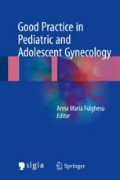Abstract
Identification of eating disorders, especially atypical or with mild restrictions of food intake is a frequent challenge for clinicians working with adolescents. The knowledge of risk and promoting factors and a basic comprehension of metabolic and endocrine mechanisms involved in adaptation to energy deficiency is helpful for the diagnostic evaluation. The recommended management of ED is multidisciplinary integrating physical and psychological support.
Access this chapter
Tax calculation will be finalised at checkout
Purchases are for personal use only
Abbreviations
- ADH:
-
Anti diuretic hormone
- ALMI:
-
Appendicular Lean Mass Index
- AMH:
-
Anti-Mullerian hormone
- AN:
-
Anorexia nervosa
- ARFID:
-
Avoidant/restrictive food intake disorder
- ARP:
-
Agouti-related protein
- BCMI:
-
Body Cell Mass Index
- BIA:
-
Body impedance assessment
- BMC:
-
Bone mineral content
- BMD:
-
(areal) Bone mineral density
- BMI:
-
Body Mass Index
- BN:
-
Bulimia nervosa
- CCK:
-
Cholecystokinin
- DSM:
-
Diagnostic and statistical manual of mental disorders
- DXA:
-
Dual X-ray absorptiometry
- ED:
-
Eating disorders
- FFM:
-
Fat free mass
- FSH:
-
Follicle-stimulating hormone
- FT3 :
-
Free 3-jodo-thyronin
- Gh:
-
Growth hormone
- GI:
-
Gastrointestinal
- GLP-1:
-
Glucagon-like peptide 1
- GnRH:
-
Gonadotropin-releasing hormone
- IGF-1:
-
Insulin-like growth factor
- IGFBP:
-
Insulin-like growth factor binding protein
- LH:
-
Luteotropic hormone
- NPY:
-
Neuro peptide Y
- PP:
-
Pancreatic polypeptide
- REE:
-
Resting energy expenditure
- SGOT:
-
Serum glutamic oxaloacetic transaminase
- SHBG:
-
Sex hormone binding protein
- SRIs:
-
Serotonin reuptake inhibitors
- TBW:
-
Total body water
References
Micali N, Ploubidis G, De Stavola B, Simonoff E, Treasure J. Frequency and patterns of eating disorders symptoms in early adolescence. J Adolesc Health. 2014;54:574–81.
American Psychiatric Association. Diagnostic and statistical manual of mental disorders (DSM 5). Washington, DC: APA; 2013.
Fuller-Thomson E, Sinclair DA, Brennenstuhl S. Carrying the pain of abuse: gender-specific findings on the relationship between childhood physical abuse and obesity in adulthood. Obes Facts. 2013;6:325–36.
Mason SM, Flint AJ, Filed AE, Austin SB, Rich-Edwards JW. Abuse victimization in childhood or adolescence and risk of food addiction in adult women. Obesity (Silver Spring). 2013;21(12):E775–81.
Roa J, Garcia-Galiano D, Castellano GM, Gaytan F, Pinilla L, Tena-Sempere M. Metabolic control of puberty onset: new players, new mechanisms. Mol Cell Endocrinol. 2010;324:87–94.
De Bond JAP, Smith JT. Kisspeptin and energy balance in reproduction. Reproduction. 2014;147:R53–63.
Evans MC, Anderson GM. Neuroendocrine integration of nutritional signals on reproduction. J Mol Endocrinol. 2017;58:R107–28.
Loucks AB. The response of luteinizing hormone pulsatility to 5 days of low energy availability disappears by 14 years of gynecological age. J Clin Endocrinol Metab. 2006;91(8):3158–64.
Baskaran C, Eddy KT, Miller KK, Meenaghan E, Misra M, Lawson EA. Leptin secretory dynamics and associated disordered eating psychopathology across the weight spectrum. Eur J Endocrinol. 2016;174(4):503–12.
Repaci A, Gambineri A, Pagotto U, Pasquali R. Ghrelin and reproductive disorders. Mol Cell Endocrinol. 2011;340:70–9.
Wolfe A, Dival S, Wu S. The regulation of reproductive neuroendocrine function by insulin and insulin-like growth factor-1. Front Neuroendocrinol. 2014;35(4):558–72.
Misra M, Klibanski A. Endocrine consequences of anorexia nervosa. Lancet Diabetes Endocrinol. 2014;2(7):581–92.
Kyle U, Bosaeus I, De Lorenzo AD, Deurenberg P, et al. Bioelectrical impedance analysis- part I: review of principles and methods. Clin Nutr. 2004;23:1226–43.
Bruni V, Dei M, Morelli C, Schettino MT, Balzi D, Nuvolone D. Body composition variables and leptin levels in functional hypothalamic amenorrea and amenorrhea related to eating disorders. J Pediatr Adolesc Gynecol. 2011;24(6):347–52.
Oskis A, Loveday C, Hucklebridge F, Thorn L, et al. Diurnal patterns of salivary cortisol and DHEA in adolescent anorexia nervosa. Stress. 2012;15(6):601–7.
International Society for Clinical Densitometry (ISCD). Combined official position. 2015. www.iscd.org
Mehler PS, Brown C. Anorexia nervosa - medical complications. J Eat Disord. 2015;3:11–9.
National Clinical Practice Guidelines CG9 The British Psychological Society & The Royal Collge of Psychiatrists 2004.
Golden NH, Katzman DK, Sawyer SM, et al. Update on the medical management of eating disorders in adolescents. J Adolesc Health. 2015;56:370–5.
Lock J. Treatment of adolescent eating disorders: progresses and challenges. Minerva Psichiatr. 2010;51(3):207–13.
Marzola E, Nasser JA, Hashim SA, et al. Nutritional rehabilitation in anorexia nervosa: review of the literature and implications for treatment. BMC Psychiatry. 2013;13:290–303.
Seetharaman S, Golden N, Halpern-Felshern B, et al. Effect of a prior history of overweight on return of menses in adolescents with eating disorders. J Adolesc Health. 2017;60(4):469–71.
El Goch M, Gatti D, Calugi S, et al. The association between weight gain restoration and bone mineral density in adolescents with anorexia nervosa: a systematic review. Forum Nutr. 2016;8:769–81.
Golden NH, Lanzkowsky L, Schebendach J, et al. The effect of estrogen-progestin treatment on bone mineral density in anorexia nervosa. J Pediatr Adolesc Gynecol. 2002;15:135–43.
DiVasta AD, Feldman HA, Beck TJ, et al. Does hormone replacement normalize bone geometry in adolescents with anorexia nervosa? J Bone Miner Res. 2012;29(1):151–7.
Grinspoon S, Thomas L, Miller K, et al. Effects of recombinant human IGF-I and oral contraceptive administration on bone density in anorexia nervosa. J Clin Endocrinol Metab. 2002;87:2883–91.
Golden NH, Iglesias EA, Jacobson MS, et al. Alendronate for the treatment of osteopenia in anorexia nervosa: a randomized, double-blind, placebo-controlled trial. J Clin Endocrinol Metab. 2005;90(6):3179–85.
Misra M, Katzman D, Miller KK, et al. Physiologic estrogen replacement increases bone density in adolescent girls with anorexia nervosa. Int J Eat Disord. 2011;49(3):276–92.
Keating C. Sex differences precipitating anorexia nervosa in females: the estrogen paradox and a novel framework for targeting sex-specific neurocircuits and behavior. Curr Top Behav Neurosci. 2011;8:189–207.
Author information
Authors and Affiliations
Corresponding author
Editor information
Editors and Affiliations
Rights and permissions
Copyright information
© 2018 Springer International Publishing AG
About this chapter
Cite this chapter
Bruni, V., Dei, M. (2018). Eating Disorders in Adolescence. In: Fulghesu, A. (eds) Good Practice in Pediatric and Adolescent Gynecology. Springer, Cham. https://doi.org/10.1007/978-3-319-57162-1_8
Download citation
DOI: https://doi.org/10.1007/978-3-319-57162-1_8
Published:
Publisher Name: Springer, Cham
Print ISBN: 978-3-319-57161-4
Online ISBN: 978-3-319-57162-1
eBook Packages: MedicineMedicine (R0)

